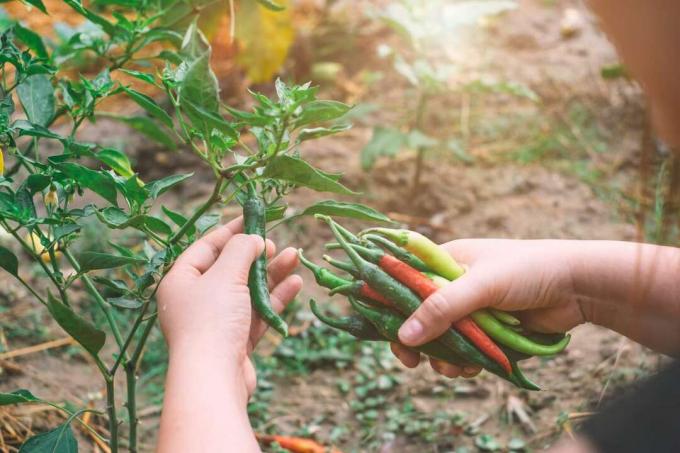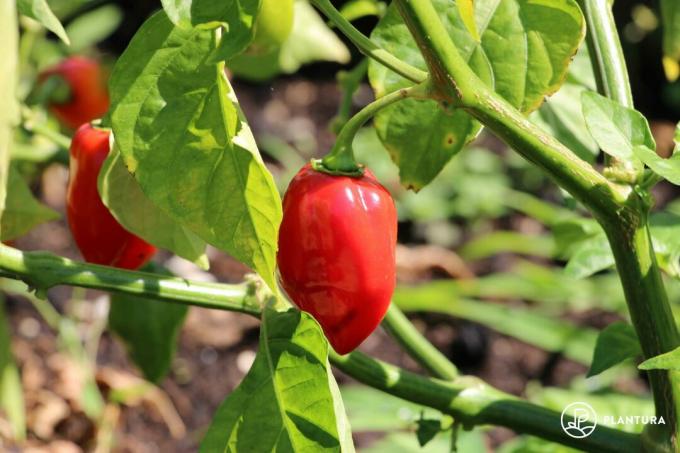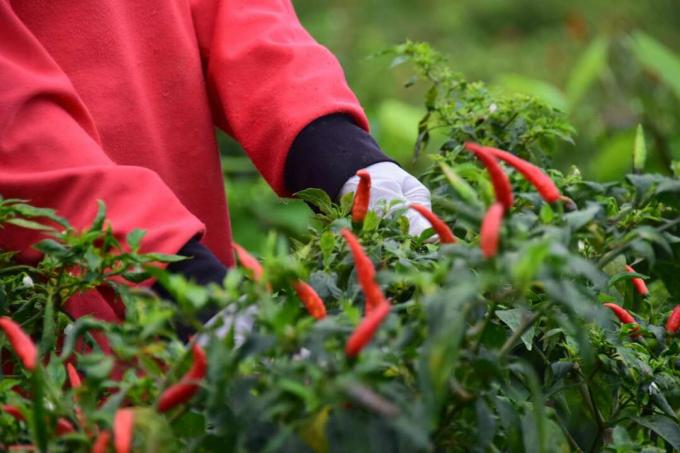In order to get the right level of spiciness, you have to be very careful when harvesting chillies. We show how to harvest and store chillies properly.

Harvesting chilli needs to be learned! Because the right harvest of the fiery pods depends, for example, on the decisive heat and aroma of the chillies (capsicum) away. Many chilli lovers ask themselves the question at some point during the summer: when should I harvest my chillies? And how do I best store my chili harvest? But if you follow a few tips and have a bit of tact, harvesting the chili becomes easy. In our article, we will tell you everything from the best time to harvest, to the correct procedure for harvesting, to how to store chillies.
contents
- When is it time to harvest chili?
- Procedure for harvesting chili
- The right level of spiciness for chillies
- Storing and preserving chili
Chilies belong to the large family of nightshades (Solanaceae) and like that
paprika to the genus capsicum The hot chilies are cultivated forms or varieties of the following five capsicum-Species: Capsicum annum, Capsicum chinese, Capsicum baccatum, Capsicum frutescens and Capsicum pubescens. Experts estimate that there are between 2,500 and 3,000 types of chili worldwide.What is most valued about chillies is their fiery, sometimes fruity spiciness. However, this is crucially related to the correct ripeness and harvest of the chillies. So to be completely satisfied with your chilli harvest, you should consider the following.
When is it time to harvest chili?
Unfortunately, one disadvantage of the incredible variety of chili varieties is that many varieties have different ripening times. A look at the seed pack can help here: It is usually noted there how long it is specific chilli variety needs to mature. Otherwise it's worth checking the internet. The ripening times of the most well-known types of chili are easy to find there.

Another important indicator that provides information about the time of harvest is the color of the chili. Chilies first discolour at the crown of the pod. From there, the discoloration then pulls down. Once the pod begins to change color, it will be completely colored within a few days. Once the chilli has completely changed color, you should be patient and give it three to five days until harvest. This is how it develops its best aroma.
Tip: If your chili plants are outdoors, the weather sometimes thwarts the full maturity of the chillies. In this case, it is advisable to harvest the chillies when they are still unripe, rather than accepting frost damage to the pods.
But not all chili varieties are harvested red. 'jalapeno' and 'Serrano' can also be harvested green. The sorts 'Yellow Hot Wax' and 'Hungarian Wax' turn yellow but never red. Finding the right time to harvest chillies is not that easy and requires practice and experience. Once the chillies have been harvested, they ripen, in contrast to tomatoes (Solanum lycopersicum), no more after.

The following signals help to determine the degree of ripeness of chili:
- color change
- The shell slowly becomes shriveled and contracts
- The flesh yields slightly when pressure is applied
- Small, black spots appear
Tip: Before you harvest all the chillies, first take just one pod and taste it. This way you can be sure that the optimal aroma and the right degree of spiciness have been reached for you.
Procedure for harvesting chili
When you finally decide that it is time to harvest, you have already mastered the hardest task. When harvesting the chillies, you should be careful not to injure the chillies. Therefore, the chili peppers should never be broken off just like that. It is better to use scissors or a very sharp knife. Now cut the chillies in the middle between the stem and the plant. Don't be put off by small discolorations and black spots. These do not mean that the chili is sick or even inedible, but is completely normal with chillies. Heavily discolored pods are no longer suitable for drying.

If you want to grow chillies again next year, you can get chili seeds right after the harvest. A chili pepper is cut in half with a knife and the seeds are scraped out with a spoon. The seeds are then laid out on kitchen paper and dried. If you win your own chilli seeds, you should know that the next generation of your chillies will no longer be true to type. Tip: Be sure to wear gloves when removing the seeds from chillies. If you are very sensitive to pungency and have a particularly pungent variety in front of you, safety goggles may also be advisable.
Summary of harvesting chillies:
- Harvest with scissors or a sharp knife
- Don't just cancel
- Cut halfway between the pod and the stem
- Black spots on the chilies are normal
- Combine harvesting with seed extraction

The right level of spiciness for chillies
Although determining when the chilli is ripe is hard enough, let's add the level of spiciness to the equation. It's true that the chili matures, it stores more and more capsaicin - the substance that makes the chili hot. But when the chili is fully ripe, it hardly stores any capsaicin. Rather, it loses some of its sharpness the longer the chilli sticks. It is best for you to test which harvest time is optimal for each individual chili variety and suits your preferences.
What other factors Hotness of chilies influence, you can read here in our article.
Storing and preserving chili
Freshly harvested chillies are best stored in the refrigerator. The pods should preferably be open and not in a closed container, otherwise condensation and mold can form. The fresh chillies keep for several weeks in the refrigerator.

If the chilli harvest was very rich and you cannot process all your chillies at once, there are many methods for preserving them. Freezing is probably the easiest way to preserve chilies. Chilies take time in the freezer very well, and frozen chilies can be used at any time like fresh chilies. Other ways to preserve chillies include drying, pickling, or boiling. Everything you about that Chillies preservation need to know can be found here.
Have you ever sowed chili seeds yourself? With our Plantura Chili Cultivation Set this is child's play. The cultivation set contains five types of chili with different degrees of heat, as well as all the materials you need for the Chili seeds need: seed pot, substrate, plant labels and a reusable one mini greenhouse.

